An Image Lexicon, or Towards a Media Archeology
Nora M. Alter
In an appendix, one can select the conversation in its entirety, just as in a book. In my contributions to a collection of filmic terminology I would also like to include the film from which I quoted in its entirety in the appendix. It is always in the inter- est of the reader to be able to check whether the quote captures the spirit of the film in general, or indeed what the relationship between the quotation and the film is as a whole.
— Harun Farocki, “A Cinematographic Thesaurus”*
Allow me to conclude with two early pronouncements by Farocki in his critique of television. The first, from “About Working with Images for Television,” explains the similarity between how producers select visual tracks in made-for-television documentaries and how mediocre poets compose verse using “rhyme lexicons.” Farocki underscores that even if the message’s intention is progressive, the cookie-cutter production process ensures that “resistance will consist of a heap of mannerisms.” 1 He makes the second pronouncement in “Images from Television,” and in the film The Trouble with Images (1973). In both, he presents two image sequences representing leisure time and the service industry. The first is of a rollercoaster, and the second of a hand that serves cake. Farocki explains that “the roller coaster image has been specifically selected by the docu-director to express, clarify, and make vivid the concept of leisure, and the image of the hand serving cake . . . to illustrate the concept of service. . . . The docu-director reaches into an imaginary lexicon.”2
The term “lexicon” surfaces multiple times in Farocki’s writings. However, instead of relating the term to words, Farocki applies it to images. As he explains much later, “I am a lover of dictionaries. I get great pleasure out of looking up words and their etymological sources in specialized and obscure lexica. . . . In searching for order in my collection of material, I have to think of dictionaries because of the way they document the usage of a word or expression chronologically, through the decades or centuries.” He continues, “It occurred to me that there is nothing comparable to a dictionary in the realm of cinema. How might one even name such a thing? One could call it an ‘illustrated book,’ a ‘thesaurus’ or a ‘treasure trove of images,’ or perhaps even an ‘archive of filmic expressions.’ ”3
Farocki regrets that, unlike the writer, who has access to many word definitions, etymologies, and synonyms, the makers of television documentaries must rely on a limited range of well-worn stock images and sequences. The patterns, compositions, and gestures that these images render are familiar. Television documentaries regularly repeat them. Accordingly, stock images of rollercoaster rides or servings of cake become typical representations of leisure. Decades later, Farocki laments that the poverty of images extends to art filmmaking as well: “Television documentaries have become formulaic, something that isn’t necessarily lost in the transition from television to the art world.”4
Farocki’s The Division of All Days (1970) and Something Self-Explanatory (15x) (1971) translate Marx’s economic theory into filmic language. In a related work, The Language of Revolution (1972), Farocki explores how cinema depicts revolutionary speech. He asks how media reproduces live rhetorical performances that actively seek to move people. We can trace his interest in revolutionary language to his review of Roland Barthes’s Mythologies. Barthes writes, “There is one language which is not mythical, it is the language of man as a producer: whenever man speaks in order to transform reality and no longer to preserve it as an image, wherever he links his language to the making of things . . . , myth is impossible. This is why revolutionary language proper cannot be mythical. . . . The bourgeoisie hides the fact that it is the bourgeoisie and thereby produces myth; revolution announces itself openly as revolution and thereby abolishes myth.”5 Like “operational language,” “revolutionary language” stands outside of the bounds of myth. How, then, can a filmmaker, whose craft mobilizes images, make a film that centers on a type of language that eschews myth?
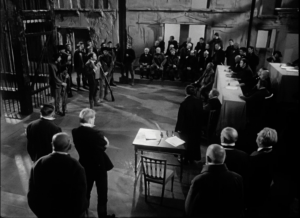
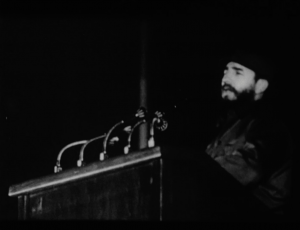 Harun Farocki, Die Sprache der Revolution (The Language of Revolution) (1972)
Harun Farocki, Die Sprache der Revolution (The Language of Revolution) (1972)
Farocki takes up this challenge in The Language of Revolution. The film focuses on five memorable revolutionary speeches. Part 1 opens with iconic images from the French Revolution and speeches by Georges Danton and Louis Antoine de Saint-Just drawn from Fritz Umgelter’s film Danton’s Tod (Danton’s Death) (1963). Part 2 shifts to late 1960s Cuba. It features newsreel footage of Fidel Castro’s television address on the economic importance of sugar production. Part 3 centers on the U.S. civil rights movement, contrasting talks by Jesse Jackson (“I am Somebody”) and Malcolm X (“The Ballot or the Bullet”). Part 4 examines a monologue by Vladimir Lenin following the Russian Revolution. Farocki’s film concludes with a late-1960s speech by Berlin-based political activist Rudi Dutschke.6 Like in Inextinguishable Fire (1969), Farocki intersperses Brechtian-style sequences, including one of a news commentator and several skits, between these five major sections.
In The Language of Revolution, Farocki addresses the change that occurs when cultural producers channel speech through new media. How is the dynamism of a live performance transformed? Is it possible for words to keep their initial unique revolutionary impetus and urgency once cultural producers record them? Can media effectively record the language of revolution, or does recording transform revolutionary language into myth? For Farocki, the revolutionary movement, the movement of words, and that of the film must correspond. He mediates Danton’s and Saint-Just’s words through the German playwright Georg Büchner’s Dantons Tod (Danton’s Death) (1835). In his drama, Büchner transcribed and translated the speeches from the original 1794 trial in France. Farocki does not film a live performance of Büchner’s play; instead, he turns to Umgelter’s cinematic version. By drawing from a film source, he underscores the speeches’ mediation and journey through history—from court records to written drama, to live theatrical performance, to feature film.
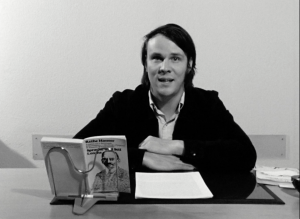 Harun Farocki, Die Sprache der Revolution (The Language of Revolution) (1972)
Harun Farocki, Die Sprache der Revolution (The Language of Revolution) (1972)
Moving forward approximately 170 years from the eighteenth-century court records and 135 years from Büchner’s dramatic adaptation, both time periods before technological recording, Farocki shifts to an era dominated by broadcast television. Castro delivered his speech in front of live cameras; he intended it for mass transmission. The Cuban leader often strategically employed television as the revolution’s broadcast medium. Decades later, Farocki shows how video assumes that function in Videograms of a Revolution (1992). Lenin’s 1919 speech presents Farocki with an interesting technological challenge: it predates television and synchronized-sound film recording. Lenin’s speech exists only as an audial recording. However, instead of playing it over a blank screen, Farocki matches stock historical footage of Lenin to sound recordings of his voice. Additionally, The Language of Revolution features a commentator analyzing Lenin’s rhetoric. The expert concludes that Lenin improvised a great deal; he did not draft his speeches beforehand but developed them while speaking. This delivery technique, the professional argues, impresses on audiences that they are taking part in the arguments’ formulation.
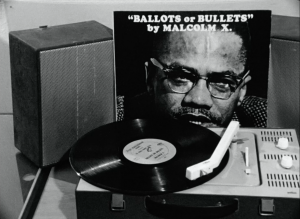 Harun Farocki, Die Sprache der Revolution (The Language of Revolution) (1972)
Harun Farocki, Die Sprache der Revolution (The Language of Revolution) (1972)
In contrast to the oral deliveries from the French Revolution courtroom, then first reenacted on the theatrical stage, cinema mobilized sound and image in the early twentieth century to help speeches reach the public.7 Forty-five years later, filmmakers used synch systems to make simultaneous audiovisual recordings. Farocki employs a 1963 clip of Jesse Jackson addressing a crowd to make this point. He avoids found footage of Malcolm X. Instead, he presents a 1964 speech by X through the medium of the record album “Ballots and Bullets.” A record is a technology on which sound, usually music, is inscribed but a record is also a legal account. Farocki sets up a turntable before a camera and drops the needle as X’s speech begins. X’s disembodied voice resounds powerfully without visual distractions. An image of X’s face from the album cover fills the screenplays with the double meaning of “revolution” as the overthrow of an order from below and vinyl records’ measure of rotation: revolutions per minute.
The Language of Revolution offers distinct possibilities for representing social revolution. The extreme reaction revolutionary language generates attests to its power. The words of several figures Farocki focuses on—Danton, X, and Dutschke—led to violence against them. Farocki includes counter speeches by Saint-Just, who condemns Danton to death, and Jesse Jackson, who represents the civil rights movement’s non-violent wing. Whereas Jackson rouses crowds to sing, X urges them to “swing” (their fists). Farocki follows Jackson’s and X’s contrasting speeches with a striking avalanche of montaged images of violence against black bodies, set to the soundtrack of Lena Horne’s “Now!” The montage is not dialectical; rather, it is associative and cumulative as it assembles a plethora of images of acts of racist brutality. Within this rapid succession of images, there is a photograph of the martyred Nazi propaganda hero Horst Wessel, composer of the Third Reich’s national anthem. The photograph forges a link between Nazi crimes and U.S. racism. The sequence ends with the word “NOW” spelled out on a bullet-ridden screen. The montage immediately strikes the viewer as being out of place or unusual in Farocki’s style. Indeed it is, as it is an appropriation of Cuban Filmmaker’s Santiago Alvarez’ 1965 award winning short Now screened at the Leipzig Documentary Film Festival that year.
The language of revolution is formula-less. Each example stands alone. At the film’s end, Farocki cautions, “To assess a speech or a text, one has to ask: Who is speaking? Who is the audience? When and where did its members live? To which class do they belong? What is the audience’s situation?” The media that record words and images and the platforms that disseminate them are as important as the words and images themselves. To achieve maximum effect, cultural producers must carefully calibrate language and, by extension, images to their target audiences. Speeches are words and sentences that combine to form a sort of movement, similar to how single images together compose moving-shot sequences in films. Like a filmmaker’s relation to images, the speechmaker must select words from various possibilities and deploy them with utmost precision. Farocki stresses that a cinematographic lexicon should include moving-shot sequences, gestures, expressions, and concepts instead of static images. Media theorist Wolfgang Ernst underscores this sentiment in a collaborative essay written with Farocki, “Given that the moving image is the first medium that can ‘store’ time, one of the greatest challenges now is how to ‘sort’ this time. Within film, time enters the pictorial archive.”8 Speechmakers deliver speeches for publics to hear. However, once recorded, the moment of reception can vary. Recording devices preserve oratorical performances in time. In The Language of Revolution, Farocki studies what happens to revolutionary language when it is translated into audio-visual media. Are certain tropes recognizable across space and time? The film comprises the first entry in his cinematographic lexicon.
A concern that Farocki returns to throughout his practice first emerges in The Language of Revolution: How does the technology that nests the grammar and style of image production determine the latter? Farocki notes, “The technological revolution has also seen the rise of particular effects that are made possible by those devices, indeed they are part of the programmes of these machines. . . . Today there are technical advances nearly every year, which produce, in turn, stylistic proclivities.”9 Farocki again addresses the correlation between a revolution, its expression, and the media that transmits it in Videograms of a Revolution.10 Working with Andrei Ujica, Farocki found that in the collected amateur video footage from Nicolae Ceauscescu’s last days, there were repetitions of the angles, shots, gestures, and images. A certain homogeneity of style emerged. Recalling Vilém Flusser, Farocki remarks, “Flusser emphasizes the manner in which any individual photograph or filmic expression is a product of programming.”11 The video anticipates the Internet’s ever growing audiovisual archive and database, made increasingly accessible by advanced search engines. The result is a potentially unlimited and readily available virtual treasure trove of information and images, however, often with the outcome of a search repeating the ever same.
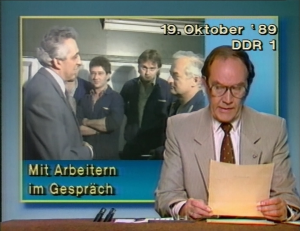
 Harun Farocki, Die führende Rolle (The Leading Role) (1994)
Harun Farocki, Die führende Rolle (The Leading Role) (1994)
In contrast to Videograms of a Revolution, compiled primarily of non-professional media images, Die führende Rolle (The Leading Role) (1994) shows how professional media shape and produce political events. Farocki created a montage film from footage of the “Fall of the Wall” and German reunification featured on public news broadcasts in former East and West Germany. He refuses the Western rhetoric heralding the “end of Communism” and the “triumph of Capitalism.” His voice-over complains about the difficulties of putting “a revolution into images.” The film begins with footage of Deutsche Demokratische Republik (DDR) dignitaries, including General Secretary Erich Honecker, visiting a workers’ celebration. Following his usual method of media analysis, Farocki repeats this footage at regular intervals throughout the production in order that new meanings might emerge. This is followed by a clip from a DDR news report from October 19, 1989, the first day Egon Krenz (the DDR’s last communist leader) assumed power. The clip, which repeats several times in the film, shows Krenz visiting a factory and speaking with workers. Farocki uses these two sequences to muse on the factory as a “historic site” in East Germany, where the keyword was “work.”

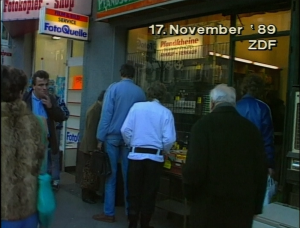 Harun Farocki, Die führende Rolle (The Leading Role) (1994)
Harun Farocki, Die führende Rolle (The Leading Role) (1994)
In West Germany, factories only enter the news when their owners shut them down or accidents occur—they are not part of everyday life. The next set of news clips follows events after the “Fall of the Wall.” They show East Germans crowding the shopping streets of West Berlin, visibly startled by the abundance of commodities and fresh produce stalls. People go on shopping sprees, exchange currency, and sell personal possessions. Farocki notes that the black market that emerged at the Cold War’s end resembled the one in the aftermath of World War II. The many media images that celebrated the “Fall of the Wall” failed to capture how the end of communism ushered in the beginnings of consumerism. They failed to recount the importance of work and the dignity of the worker in the former DDR. Farocki produces a view that differs from the standard narrative of capitalism’s triumphal march touted by dominant news broadcasts. His final words in the film, “a revolution buried in images instead of emanating from them,” underscore how broadcast media produces a history that conforms to and confirms dominant ideology (Western capitalism) through repetition of the eversame. They overlap with Flusser’s claim that today’s world is made of images.
Farocki pursues how communication media (press, radio, television, film—that is, mass media) translates, performs, and creates politically transformative events in The Language of Revolution, Videograms of a Revolution, and The Leading Role. In these productions, Farocki explores how communication media encodes revolutionary words and actions into new modes, and he subsequently decodes them as images of revolution. The productions repeat common rhetorical, gestural, stylistic, or movement-based characteristics for each event. They implement the real. The revolutions live on as media myths. Myths that will obscure other histories and truths.
Farocki articulates his conception of a media archive or library in an early unpublished text, “What Ought to Be Done” (1975/76).12 Here, he imagines a research institute for nonfiction films that would include a “national image library” (nationale Bilderbibliothek) that filmmakers and documentarians could access. The concept of an image library evokes Aby Warburg’s never completed project Mnemosyne Atlas. Whereas Warburg centered on still images from antiquity to the present, Farocki’s proposal considers an image bank of moving-media sequences and nonfiction images. Farocki was aware of the conundrum faced by filmmakers who rely on present-day images that will soon be out-of-date. He writes, “What one calls documentation, that shows the world as if it was known, has the effect that in a few years, we can no longer experience what it really looked like. Images must be made with which today’s strange world can be discovered and the present becomes history. We need to produce building blocks. First, we need to develop them, then we have to assemble and dissemble them.”13 Depictions filmmakers make of historical events can function as building blocks for other filmmakers to assemble their projects. Moving images, like bricks, form the architectural structure of a film. However, filmmakers must ensure that these stored image blocks are neither standardized nor clichéd to avoid prefabricated future constructions.
The idea of a storage system image or archive for moving images that intrigued Farocki extended beyond documentary footage. In a 1982 review of John Cassavetes’s Too Late Blues (1961), Farocki focused on a baseball game scene: “I am a collector of such scenes and images. If I wanted to make a book with them, I’d write to the publisher requesting images that resemble Moments musicaux (musical moments). These images should function like picture headlines: the chalk mark on the shoulder, the large shadow cast by the balloon seller in The Third Man,” and so on.14 Farocki, in a cinephiliac gesture like Jean Epstein’s theory of photogenie, identifies and collects remarkable shots from film history that resonate long after the plot and narrative fade. Productions such as Workers Leaving the Factory (1995) bring together some of these shot sequences. As Farocki describes it, “A new archive system is thus on its way, a future library for moving images, in which one can search for and retrieve elements of pictures. Up to now, the dynamic and compositional definitions of a sequence of images—those things that are the decisive factor in the editing process of converting a sequence of images into film—have not been classified nor included.”15
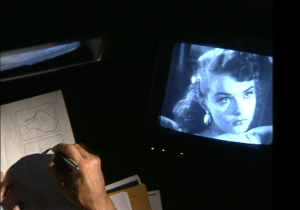 Harun Farocki, Der Ausdruck der Hände (The Expression of Hands) (1997)
Harun Farocki, Der Ausdruck der Hände (The Expression of Hands) (1997)
In the essay film The Expression of Hands (1997), made two years after the release of Workers Leaving the Factory, Farocki studied body techniques to actualize a “moving image archive.”16 The short begins with an analysis of the opening scene of Sam Fuller’s Pickup on South Street (1953). In this sequence, Fuller films the hands of a thief in a crowded subway as the latter deftly opens a woman’s purse and removes her wallet. A rapid shot/counter- shot series between the hands and the woman’s face ensues, with her expression inexplicably suggesting erotic arousal. Farocki observes, “The hands do something different than the face.” The Expression of Hands analyzes shots of hands and hand gestures from film history. The influence of Vilém Flusser is again apparent as Farocki, to a certain extent, actualizes in an audiovisual format theories proposed by the philosopher in his 1991 study on gestures.17 In his investigation into the language and science of gestures, Flusser focuses on hands as a means of expression. For his part, Farocki creates a filmic archive that in its entirety spans from an early 1908 film featuring a close-up shot of the hands of a female thief, who hides jewels in a bar of soap, to myriad sequences from labor, propaganda, horror, music, and contemporary war films. In one instance, he plays sequences from a U.S. New Deal documentary focusing on labor between 1934–1937. In another, he uncovers how propagandists mobilized the same images from the New Deal documentary for a pro-war film in 1944. As in The Trouble with Images, Farocki deploys the same stockpile of footage for different aims.
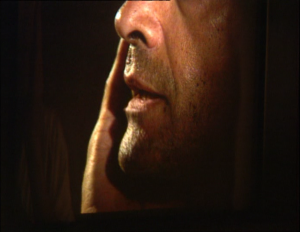 Harun Farocki, Der Ausdruck der Hände (The Expression of Hands) (1997)
Harun Farocki, Der Ausdruck der Hände (The Expression of Hands) (1997)
Farocki’s 1980 essay on editing has a section entitled: “Gestic Thinking.” For Farocki, edited sections of a film, those image blocks put together to build a production, must contain the equivalent of a “gestus”—a clear character gesture or movement included within each edited sequence. Unlike still images that express emotions, or staged poses in photographs or paintings, gestus is a technique of acting. It depends on movement. Gestus codifies cinematographic gestures across time and space. It operates synecdochically and must contain something of the whole within its form. The hermeneutic circle reemerges in Farocki’s gestic regime as part of the social expression, which contains within it a whole. Concomitantly, the whole comprises gestic thinking.18 Farocki includes clips from classic silent films such as Robert Wiene’s The Hands of Orlac (1924) and Louis Buñuel and Salvador Dalí’s Un Chien Andalou (An Andalusian Dog, 1929), along with the scene from Pickup on South Street. Indeed, the silent film era holds a particular significance for Farocki because the absence of sound gives visual expressions greater meaning—it helps images to develop their own language. Leafing through an old textbook on sign language, Farocki wonders if filmmakers would have developed a cinematic language of visual signs if engineers had not discovered sound technology. A few minutes later, as if responding to his question, he presents a 1927 book on gestural acting in cinema: Dyk Rudenski’s Gestologie und Filmspielerei (Gestures and Filmacting). He pauses over sections of this tome that explain the subtle nuances of the expression of hands. These include the difference between the fingers of a clenched fist facing the hand owner or away from that person, or between a slap delivered with the palm or the back of the hand. Hands, Farocki observes, are the only part of the body that one can see from every angle. A sequence of frozen fingers that cannot light a match and clips of maimed hands point to this delicate body part’s vulnerability. Hands are crucial for labor, whether it be a skilled craft or a factory assembly line. Farocki presents a 1944 Nazi propaganda film about making a violin as an example of handcraft. The featured artisan gently bends and joins the pieces of wood. The film also highlights clips of hands shooting guns or strangling people. However, according to Farocki, piano players’ hands are the most beloved in cinema. Perhaps this has to do with the likeness between the operation of a piano player’s hands and audiovisual images. Like the process of the piano player, whose hands play two distinct lines of music at once, counterpoint in film creates multiple narratives and meanings.
In The Expression of Hands, two hands in particular appear more frequently throughout the production. Sometimes they frame an image; other times, they sketch on paper, illustrating a concept. Occasionally, the production depicts the hands at rest. Their long brown, slender fingers and delicate structure identify them as Farocki’s. Many of his films feature them. They represent the craft, labor, and artistry that goes into his works. Farocki was transitioning from analog to digital editing systems when he made The Expression of Hands. With the transfer to digital came a loss of films’ indexical nature. Also lost was film’s tactile dimension, with the filmmaker’s operation of passing a celluloid strip between fingers replaced by computer strokes. Digital technology streamlines dexterity from the hand to the fingertip. Computer programs replace manual labor, all that remains is the root word.
The Expression of Hands is one of Farocki’s most intimate films. He made it shortly after the death of Ursula Lefkes, his wife of thirty years and mother of his daughters. His distinctive voice guides spectators through the text, punctuating significant moments. Early in the film, Farocki reveals a distorted reflection of his face on the editing screen. At another moment, he illustrates Rudenski’s argument that unlike the palm, which evokes emotion, the hand’s back signifies intellectual expression. Following Rudenski’s example of the courteous handkiss, Farocki films himself first lowering his mouth to kiss the back of his hand formally and then bringing his lips to kiss his open palm more intimately. At the end of the film, he concentrates on hands that bring or depict death. The final example features a close-up of the last gestures of a dying man’s hand. Farocki’s face appears on screen as the man’s hand stops moving. He speaks the film’s last words: “The essence of life is freed.” And here we recall Flusser on the gesture of freedom, who writes, “Freedom is actually indivisible: it is the way we recognize that others are in the world with us.”19
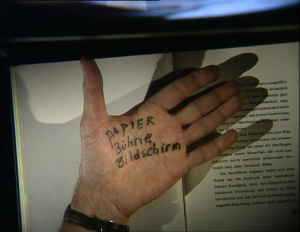 Harun Farocki, Der Ausdruck der Hände (The Expression of Hands) (1997)
Harun Farocki, Der Ausdruck der Hände (The Expression of Hands) (1997)
In The Expression of Hands, Farocki writes three words on his hand: Papier Bühne Bildschirm (paper stage screen). Thirty years after the ending of Their Newspapers (1968) that features the game “paper rock scissors,” Farocki exchanges the political tools of rocks and scissors for stages and screens. Each stands for a different expressive medium. Writing words, performing gestures, and making images translate thought into tangible and visible signs. The commentary explains that cinema is a medium based on seeing, not touching; it converts touch into the gaze, just as acting expresses social attitudes on stage. By focusing on hands, Farocki shows how these appendages encode, convey, and transmit attitudes; their range of expression is seemingly unlimited. However, once we codify their structure into a lexicon, we can read gestures like a language, with their movements acting like signifiers.
Not only can techniques of the body be indexed and made readily available for reference, retrieval, and reuse, but so too can the backgrounds, settings, and geographies in which filmmakers stage them. In his review of Volker Vogeler’s Das Tal der tanzenden Witwen (Valley of the Dancing Widows, 1975), a German/Spanish Western–comedy, Farocki describes the generic character of the Western landscape. He notes filmmakers typically depict the Western landscape in a way that makes it impossible to grasp in its totality. The way filmmakers angle their shots of characters against the sky makes specific locales unrecognizable. The result is a familiar visual patterning that becomes the signature trope of the Western genre: “The valley is never visible. You can’t get an idea of the layout of the (Western) town. . . . You can’t imagine that a particular landscape surrounds the town. Filmmakers typically shoot the exterior shots against the sky. I was told that this film town in Spain was on a hill, so that filmmakers could do everything without background localization.”20 This production process is based on genre formulas that generate form and content like the made-for-television documentaries that Farocki decried earlier. Filmmakers suspend the resulting films in an artificial world that avoids pointers or markers of specificity and the real. As will later be the case with video games, players in this false world move through interchangeable virtual landscapes.
Forty years after Vogeler’s Valley of the Dancing Widows, Farocki delivers an almost identical desert-valley landscape in Parallel II (2014), the second of the four in the series. However, the scene has been digitally manufactured and it serves as the backdrop for the video game Red Dead Redemption. Furthermore, Farocki offers up another game in a non-specific 1950s film noir Hollywood set and yet another in a generic war zone. Parallel I–IV (2012–2014), Farocki’s final work, completed shortly before his death, is a four-channel video installation. When first exhibited at New York City’s Greene Naftali Gallery in September 2014, the work comprised four screens suspended in the middle of the gallery. The screens formed a cube-like space that viewers circumnavigated as they watched the looping sequences. Two screens comprise double-channel videos (I and III); the other two (II and IV) are single-channel projections.

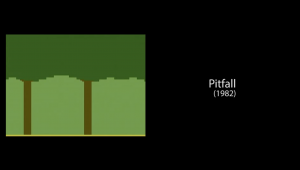
 Harun Farocki, Parellele I (Parallel I) (2012)
Harun Farocki, Parellele I (Parallel I) (2012)
Farocki produces a media archeology of the video game for the Parallel series. He begins with a visual history of video games’ development from crude single-line graphics to denser images that start to proximate analog reality. He uses a tree to show the incremental complexity of CGI (computer-generated imagery) technology. “A tree is a tree,” Barthes writes towards the beginning of “Myth Today.” But he continues, “A tree as expressed by Minou Drouet is no longer quite a tree, it is a tree which is decorated, adapted to a certain type of consumption, laden with literary self-indulgence, revolt, images, in short with a type of social usage which is added to pure matter.”21 Later in this essay, Barthes returns to the tree and woodcutter to distinguish between language-object and metalanguage. Farocki, in “War Always Finds a Way,” traces his use of the term “operational” to Barthes. He refers explicitly to Barthes’s reflection on trees in “Myth Today” as crucial to his understanding of the term. Thus, Farocki’s decision to begin Parallel by drawing attention to a tree beside a house and tracking the “historical representation of the tree in computer games” is a further nod to his indebtedness to Barthes. The tree develops historically from serving as a non-functional (operative) component to becoming the image equivalent of meta-language in games. Yet, if Barthes granted priority to culture over techniques, extending the sovereignty of culture into the domain of technology, Farocki now begins to grant priority to techniques, thereby reversing Barthes’s thrust. Rather than projecting notions of culture into technology, he now projects technology into culture. He recognizes that the materiality and technicity of digital media technologies have thoroughly permeated the cultural techniques so obviously on display in video games.
In the early games of the 1980s, such as Mystery House (1984), Pitfall (1982), and King’s Quest (1984), trees operated as props without a function. However, by decade’s end, computer programmers added functionality to the trees, and they became an integral part of the narrative and game strategy. From lines to pixilated squares to more densely developed images, programmers transformed simple trees into blossoming flora whose wind-swept leaves sway uniformly and predictably. Farocki programs and controls everything in Parallel I; the glitch or “zero-day” do not exist.
For Farocki, computer games were the natural outcome of the film studio set. Parallel I depicts the four essential elements—fire, water, earth, and air—in the new game world. This first segment of the Parallel series is a dual-channel projection, with the computer game playing on one screen and informational titles on the other. Farocki juxtaposes a series of contrasting images. One of these compares analog film clips of a field of grass (earth) swaying in the wind to CGI of a sky with clouds (air). As the commentary notes, there are two types of wind in cinema, natural and machine-produced. In contrast, there is only one type of wind in computer graphics. The CGI’s flickering connotes the indexical “reality” of the analog clips. The commentary muses, “Maybe computer-generated images will assume functions previously held by film; maybe that will liberate them for other things.” The segment ends with the pronouncement: “The computer images try to achieve the effect of the film images. They want to surpass them, leave them far behind. They don’t want to attract birds but creatures of their own design.” Infinite representational possibilities open up once a metaverse moves beyond indexically imitating the natural world.
Parallel II investigates Mindcraft, a game where players build their worlds. Mindcraft’s programmers actualized a new community of spectators alongside active gamers, followers who watch the games and identify with players, following their actions. Parallel II’s opening evokes the solipsistic viewpoint of a child who believes that all that passes by the window on a long train or car ride has been placed there specifically for them. The narrator asks: “Does the world exist if I am not watching it?” A stark virtual reality appears out of nothingness and disappears just as quickly. The narrator continues: “Where does this world end? This world appears infinite, generated by the gaze that falls upon it.” The suggestion is that vision determines existence but changes with technology.22
The existence of walls and invisible borders for players to transgress is a key feature of video games. Programmers of these virtual worlds inscribe ideology into them. The popularity of the U.S. myth of the West in these games has much to do with the way the myth nostalgically appeals to a previous Hollywood era that celebrated Manifest Destiny’s expansion of territory and turned a blind eye to the genocidal bloodshed accompanying it. Though Hollywood has reconsidered this popular film genre, its earlier glory and much of its ideology thrives within the gaming industry, propelled by the endless drive for conquest, frontier crossing, and colonizing new virtual territories. Parallel II captures video games’ evocation of unfettered freedom in a striking scene where a player breaks through the program’s borders and virtually tumbles into an unbuilt environment. With nowhere to go, the player is caught in a forever time loop.
Parallel III continues the earlier segments’ investigations of borders, thresholds, and realities in a virtual environment the narrator says “ends like a board game.” This production focuses on the objects and props that furnish these environments. “Objects have no existence by themselves; by themselves, they are nothing,” states the narrator. The objects in these environments require a game character to make them signify. Farocki draws parallels between the film camera’s movement and the gaze that animates elements in the virtual worlds. A representation of a body of water in one of these worlds does not signify until a character, with whom the gamer is closely aligned, touches its surface. Even then, the water’s surface seems hollow, with no water below. It appears to float on its own like an island in a primeval ocean—all simulation.
Parallel IV focuses on creating the actants. This last segment of the series opens with the declaration that heroes are figures thrown into the world without parents or teachers to instruct them. Instead, they must learn the game’s rules through trial and error. Again, Farocki bases figures on archetypes; these include medieval figures on quests who develop through their adventures. Figures perform according to set codes and morphologies. Farocki presents the video game as a modern-day Bildungsroman. Participants learn the actions and gestures video game figures perform, such as pushing, bumping, resisting, and handling firearms. Farocki studies how this coded technology enables the participant, in the form of a virtual protagonist, to acquire additional skill sets that determine future behavior and advancement through the narrative. Farocki thus anticipates the learning potential of artificial intelligence (AI). The segment’s final sequence centers on a male character violently threatening a female Asian store-clerk figure.
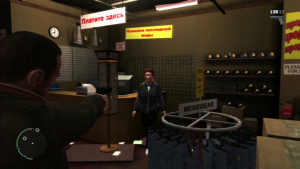 Harun Farocki, Parallele IV (Parallel IV) (2014)
Harun Farocki, Parallele IV (Parallel IV) (2014)
Although the clerk flees the shop, the videogame designers have not programmed her to learn and therefore be able to escape completely (she is not the hero of this game). Instead, she too is caught in a time loop, repeatedly returning to the scene of the crime. The commentary’s final words attest to “the limitations of human freedom of action” within these built environments and underscore the clerk’s repetitive behavior. In the end, agency is purely ideological, the product of programming. Programmers write players into fully encoded worlds. Survival is the primary goal in these worlds, and to survive necessitates eliminating as many adversaries as possible. The players must knock off even potential adversaries. Itis, therefore, no surprise that programmers develop gaming and war industries in tandem and that the two technologies seamlessly converge. Their alliance is uncomfortable in its natural comfortableness.
While programmers use algorithms to generate new products, they also recognize that computer processes have an enormous potential to identify, classify, and archive vast media banks of sounds and images. In a speech at the 3rd International Flusser conference in 1999, Farocki acknowledges how digital technology allows him to realize his earlier dream of a moving-image lexicon. Citing Ernst, with whom he collaborated on the Suchbilder (Search Images) project, he states: “In principle, images (and their soundtracks) can be made accessible, sorted and archived by adequate algorithms of pattern recognition in a way that was previously inconceivable in the context of analog human image and motif associations.” Ernst continues, “The digital image archive is thus able to identify image and sequence similarities that lie beyond the iconological fixation of the human gaze on content, on semantics, and to literally excavate a media-archaeological image knowledge, an ‘optical unconscious’ (Walter Benjamin), such as only technical media are able to generate.”23 As Farocki shows in Parallel I–IV, despite enormous technological advances, the backgrounds, structures, characters, and plots of moving-image productions remain the same. Algorithms identify gestic moments of expression, such as avoiding obstacles and pulling guns in video games. Gestus has thus migrated across media from live theater to film, television, and now CGI. Accordingly, the virtual world of the gaming industry provides yet another platform for Farocki’s lifelong dismantling of image production into its constituent parts. What began with television producers creating formulaic sounds and images has metamorphosed into computer-generated algorithms that seem to take on a life of their own. And just as AI can generate characters and stories, one wonders if, in the future, makers will produce entire films through algorithms—productions that will stand as quintessential operational films.24 Farocki began as a writer who used words to decode, analyze, and critique contemporary society. With the same goal in mind, he moved on to film, video, and digital technologies over the years. Whatever his media, he rigorously and unrelentingly interrogated the translation of thought into language, never losing sight of the fact that media function according to the repetition of specific codes in the form of words, phrases, gestures, body techniques, pictures, images, and shot sequences. Similar to how critical writers use words in their analyses, Farocki consistently sought to employ images to make arguments. His filmic essays operate as forms of intelligence.
*The epigraph comes from Harun Farocki and Wolfgang Ernst, “Towards an Archive for Visual Concepts, Part 2: ‘A Cinematographic Thesaurus,” in Harun Farocki: Working on the Sight-Lines, ed. Thomas Elsaesser (Amsterdam: Amsterdam University Press, 2004), 281.
- Harun Farocki, “Über die Arbeit mit Bildern im Fernsehen” [1974], in Harun Farocki: Meine Nächte mit den Linken; Texte, 1964–1975, ed. Volker Pantenburg (Berlin: Harun Farocki Institut/n.b.k., 2018), 173.
- Harun Farocki, “Bilder aus dem Fernsehen” [1973], in Pantenburg, Harun Farocki, 144–45.
- Farocki, in Ernst and Farocki, “Cinematographic Thesaurus,” 273.
- Harun Farocki and Hito Steyerl, “A Magical Imitation of Reality,” Cahier #2 (Milan: Kaleidoscope Press, 2011), 20.
- Roland Barthes, “Myth Today,” in Mythologies [1957] (London: Vintage Books, 1993), 146.
- In 1968, a right-wing activist shot Dutschke in an assassination attempt. Farocki, with Sander, made the short Drei Schüsse auf Rudi (Three Shots at Rudi) (1968).
- As Jonathan Sterne argues, records were initially intended for courtroom use to produce more accurate accounts of trial proceedings. Their use in musical reproduction was an unintended consequence. For a fascinating history of the development of recorded music, see Jonathan Sterne, The Audible Past: Cultural Origins of Sound Reproduction (Durham, NC: Duke University Press, 2003).
- Ernst, in Ernst and Farocki, “Cinematographic Thesaurus,” 265.
- Farocki, in Ernst and Farocki, “Cinematographic Thesaurus,” 279.
- For an insightful essay on how Farocki and Ujica analyze media images, see Benjamin Young, “On Media and Democratic Politics: Videograms of a Revolution,” in Elsaesser, Harun Farocki, 245– 260.
- Farocki, in Ernst and Farocki, “Cinematographic Thesaurus,” 279.
- Harun Farocki, “What Ought to Be Done” [1975– 76], in What Ought to Be Done: Document, Commentary, Material, ed. Harun Farocki Institut, trans. Volker Pantenburg and Michael Turnbull (Berlin: Harun Farocki Institut/Motto Books, 2016), 3– 8.
- Farocki, “What Ought to Be Done,” 4– 5.
- Harun Farocki, “John Cassavetes: Too Late Blues” [1982], in Harun Farocki: Ich habe genug! Texte, 1976–1985, ed. Volker Pantenburg (Berlin: Harun Farocki Institut/n.b.k., 2019), 375.
- Harun Farocki, “Workers Leaving a Factory” [1995], in Elsaesser, Harun Farocki, 238.
- In his poignant homage to Farocki, Raymond Bellour uses Expression of Hands as a touch-stone to discuss Farocki’s invaluable contribution to an understanding of cinema. See Raymond Bellour, “Pourquoi Harun nous était si précieux,” Trafic 93 (Spring 2015): 66–74. For theorized body techniques, see Marcel Mauss, “Technology of the Body” [1934], 216, in Incorporations, ed. Jonathan Crary and Sanford Kwinter (New York: Zone Books, 1992), 454–477.
- Vilém Flusser, Gestures [1991], trans. Nancy Ann Roth (Minneapolis: University of Minnesota Press, 2014).
- In his laudatory review of Ingemo Engström’s Kampf um ein Kind (Struggle Over a Child, 1975), Farocki praises her film because it “is one of the few, in which one sees that the pieces are assembled. This alone would not be enough; the pieces must be put together in a way that both piece and whole remain present in the reception.” Harun Farocki, “Kampf um ein Kind” [1975], in Pantenburg, Harun Farocki, 227.
- Flusser, Gestures, 70.
- Harun Farocki, “Das Tal der tanzenden Witwen” [1975], in Pantenburg, Harun Farocki, 230.
- Barthes, “Myth Today,” 109.
- For an insightful critique on how screen technology has changed natural vision see Jonathan Crary, Scorched Earth: Beyond the Digital Age to a Post Capitalist World (New York: Verso, 2022).
- Farocki citing Ernst in Harun Farocki, “Bilderschatz” [1999], in Harun Farocki: Lerne das Einfachste! Texte, 2001–2014, ed. Volker Pantenburg (Berlin: Harun Farocki Institut/n.b.k., 2022), 26. Farocki’s lengthy citation of Ernst takes place at the end of his lecture in response to a question from the audience. Farocki’s answer is not included in the English reprints of “A Cinematographic Thesaurus.”
- Current research in AI suggests that this has already been achieved. A collaborative MIT project, In Event of Moon Disaster (2019), by Halsey Burgund and Francesca Panetta takes a contingency speech written for Nixon in the advent that the Apollo 13 space mission were to have been a failure and combines it with documentary footage of Nixon to produce an alternative history. See “In Event of Moon Disaster,” MIT Center for Advanced Virtuality, https://moondisaster.org
Excerpted from Harun Farocki: Forms of Intelligence by Nora M. Alter. Copyright (c) 2024 Columbia University Press. Used by arrangement with the Publisher. All rights reserved.
August 20th, 2024 — Rosa Mercedes / 06